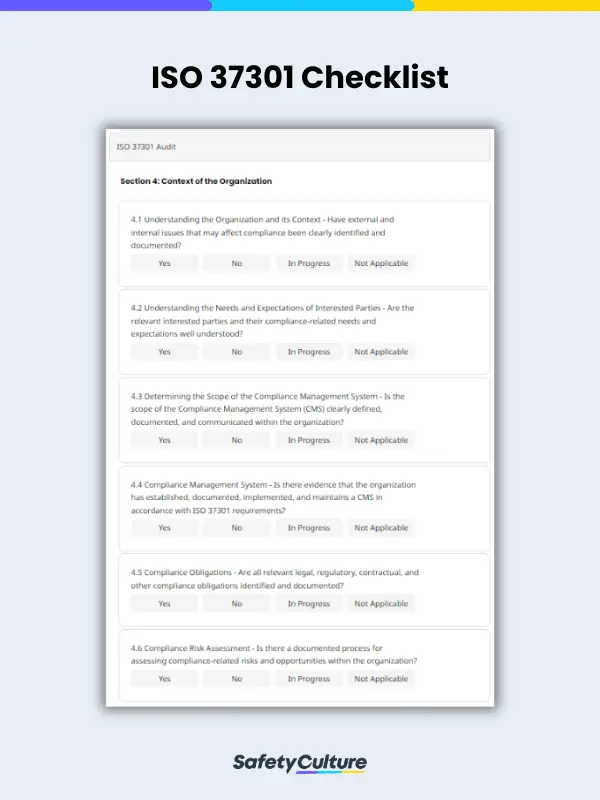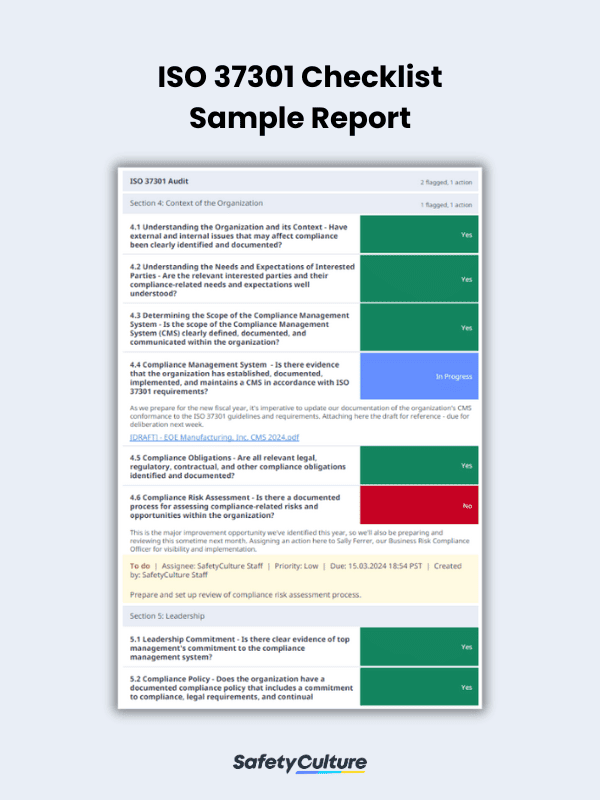What is an ISO 37301 Checklist?
An ISO 37301 checklist is a structured tool used by organizations to assess and ensure compliance with the requirements outlined in ISO 37301:2021, the international standard for compliance management systems developed by the International Organization for Standardization (ISO). The checklist is designed to systematically guide organizations through the various clauses and elements of the ISO 37301 standard, helping them evaluate their current practices and identify areas that may require improvement or further development.
Why Use a Checklist for Auditing ISO 37301 Conformance
ISO 37301 provides a framework for establishing, implementing, maintaining, and continually improving a CMS within organizations across various industries, including finance, healthcare, manufacturing, and technology. Companies can seek third-party certifications to prove their conformance to the standard and ensure they’re regularly keeping their systems up to date with the standard’s guidelines.
With complex requirements outlined in the standard that need keen attention, organizations need a handy tool to help them streamline their audits on whether their compliance management system is ISO-conforming.
This is where an ISO 37301 audit checklist is helpful and provides the following benefits to those who use it:
Systematic Evaluation
By breaking down the standard into specific items or questions, auditors can methodically review and evaluate the organization’s practices against the defined requirements of the ISO standard.
This systematic evaluation minimizes the risk of overlooking critical components, providing a comprehensive overview of the compliance management system.
Comprehensive Coverage
The checklist comprehensively covers all relevant clauses and elements of the ISO 37301 standard, preventing oversight and facilitating a thorough examination of the organization’s compliance management practices. This is also instrumental in conducting a holistic assessment aligned with ISO 37301 requirements.
Standardization and Consistency
Checklists promote standardization in the audit process, ensuring that different auditors within an organization follow a consistent approach. This ensures accurate and fair assessments, allowing organizations to maintain a unified and standardized approach to compliance management.
Documentation of Findings
Beyond the audit itself, a checklist helps auditors easily document their findings by using its sections and fields to provide tangible evidence of compliance strengths and areas for improvement. This documentation is invaluable for internal reviews, management assessments, and as a reference during external certification audits.
Also, the checklist’s role in documenting findings enhances transparency and accountability in the organization’s commitment to compliance.
Preparation for Certification Audits
For organizations aspiring to achieve ISO 37301 certification, a checklist is a vital preparatory tool. It helps identify areas that may require attention before undergoing a formal certification audit by a third-party certification body.
By addressing potential gaps through internal audits, organizations can enhance their readiness and increase the likelihood of a successful certification process.
What to Include in an ISO 37301 Checklist
Developing a comprehensive ISO 37301 checklist is a foundational step in ensuring the effective implementation and continual improvement of a compliance management system. By understanding what to include in an ISO 37301 checklist, organizations can enhance their ability to identify, assess, and address compliance-related risks and opportunities, ultimately fostering a culture of sustained legal and regulatory compliance.
Make sure to include the following core areas in the checklist to ensure a comprehensive ISO 37301 conformance audit:
- Section 4 — Context of the Organization
- Section 5 — Leadership
- Section 6 — Planning
- Section 7 — Support
- Section 8 — Operations
- Section 9 — Performance Evaluation
- Section 10 — Improvement
How to Conduct an ISO 37301 Audit Using a Checklist
Conducting an ISO 37301 audit using a checklist is a structured and methodical process designed to assess an organization’s compliance management system against the requirements of the ISO 37301:2021 standard.
This section guides how to effectively conduct such an audit, ensuring a systematic and comprehensive evaluation of the organization’s commitment to legal and regulatory compliance.
1. Prepare for the Audit
Before initiating the audit, it’s essential to thoroughly familiarize the audit team with the ISO 37301 standard. One of the major tasks in this stage includes reviewing the organization’s compliance policies, procedures, and relevant documentation.
Based on the results of the review, the ISO 37301 audit checklist must be customized to align with the organization’s specific context, industry, and compliance needs.
2. Contextualize the Organization
Begin the audit by assessing how well the organization understands and has addressed the contextual factors outlined in ISO 37301. Use the checklist to evaluate the identification of external and internal issues, including the needs and expectations of interested parties.
Also, ensure that the organization has a clear understanding of its operating environment and how it may impact compliance objectives and performance.
3. Assess Leadership Commitment
Evaluate the commitment of top management to the ISO compliance management system. Use the checklist to verify the existence and effectiveness of the compliance policy, ensuring it aligns with the organization’s overall objectives.
Also, make sure to include items related to the communication of the policy and the establishment of measurable compliance objectives.
4. Evaluate Planning and Implementation
Use the checklist to assess the identification and management of compliance-related risks and opportunities. Verifying the establishment of measurable compliance objectives and the development of plans to achieve them helps you assess the organization’s operational planning and control processes.
Ultimately, this ensures the availability of effective measures in place to meet compliance requirements.
5. Evaluate Performance
Conclude the audit by using the checklist to evaluate internal audit programs and management reviews, as well as verify the processes for identifying, documenting, and addressing nonconformities and implementing corrective actions.
Ensure that the organization has mechanisms for continually improving the suitability, adequacy, and effectiveness of its compliance management system.
ISO 37301 Checklist Example
Gain insights into the key elements to consider including and utilizing in an ISO 37301 checklist using this practical example. You can also use this as a guide for assessing and enhancing your organization’s CMS toward achieving ISO 37301 conformance:
FAQs About ISO 37301 Checklists
Organizations should use an ISO 37301 checklist regularly, incorporating it into their compliance management routine. This includes initial implementation, periodic internal audits (e.g., quarterly, biannually, or annually), and as part of continuous improvement efforts.
Regular use, which can vary per industry and organization, ensures that the compliance management system remains aligned with ISO 37301 requirements, facilitates ongoing monitoring of performance, and helps identify areas for enhancement.
While an ISO 37301 checklist is a valuable tool for internal assessments, preparation, and improvement of a compliance management system, it’s not a substitute for the formal certification process. Certification typically involves a comprehensive evaluation by a third-party certification body.
However, organizations can use the checklist to prepare for it by addressing key requirements and identifying potential gaps, contributing to a more successful certification process.
An ISO 37301 checklist provides a comprehensive overview of the key requirements outlined in the ISO 37301:2021 standard for compliance management systems. However, it may not cover every specific nuance or context of an organization. Additional considerations may be necessary based on the organization’s unique industry, size, and compliance needs.
Users of the checklist should remain informed about updates or changes to the ISO standard and be prepared to tailor the checklist to their specific circumstances, ensuring a more exhaustive and accurate assessment of their CMS.




